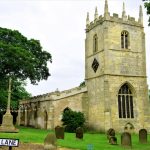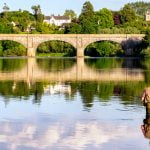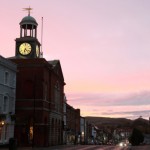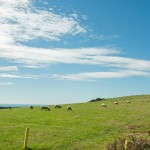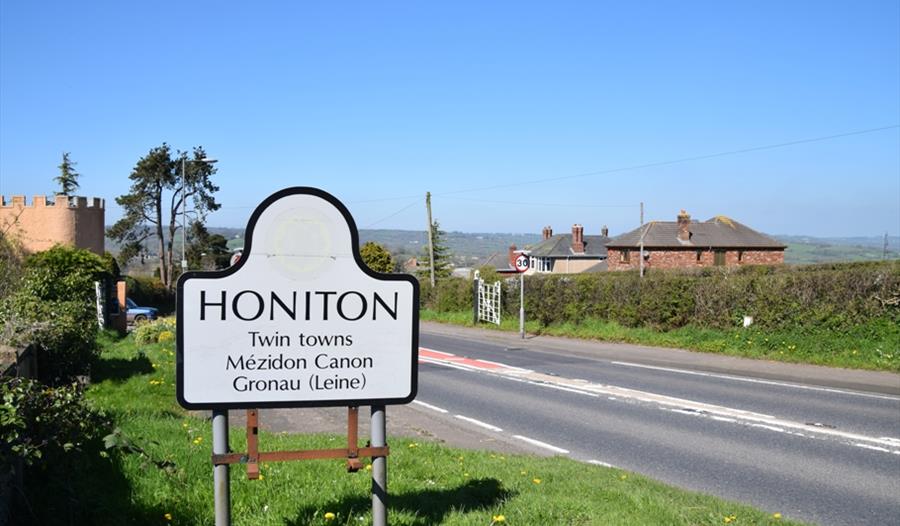
Honiton England’s Lace Capital
If you go searching in the rolling countryside of East Devon sooner rather than later you will stumble across the beautiful and lively market town of Honiton, famous throughout history for its lace and pottery. Largely unspoiled by modern advances (think poorly bolted on housing developments so prevalent in many market towns) this is a place that should be on everyone’s to visit itinerary if they are in the South West.
Located on the banks of the River Otter, Honiton lies in an area of natural beauty and of course has the best antique shops in the region. Add to this its friendly locals and long and interesting history and you have yourself the perfect base to explore the region or even better just chill and let the wonderful scenery melt all your troubles away.
Anyway, whether you are planning a holiday in the region or just a staycation, join us for the Five Minute Spare whirlwind tour of what Honiton has to offer, starting with a little bit of the towns long and interesting history…
Brief History of Honiton
Honiton is some guise has been around since the first century and some sources refer to it having originated as a small trading settlement alongside the regions main Roman road the Fosse Way around 48AD. It is mentioned in the Doomsday Book as having a mill and 100 sheep and around this time William the Conquerer gifted the parish to his half brother Robert Earl of Moreton.
It changed hands a few times subsequently, most notably when Isabella de Fortibus sold it along with the Isle of White and her other lands in devon to King Edward I in 1293 (or 1297 depending upon which source you read). It was soon afterwards transferred to Hugh de Courtenay The Earl Of Devon and it remained in the family until their heir line died out in 1556.
James 1 was the next to profit from the town selling the title of 1st Earl of Devonshire to William Cavendish, in 1618 for a then considerable sum of £10,000. The English Civil War saw everything change again but by now the town was on the map for something rather different – lacemaking which arrived thanks to the influx of Flemish refugees in the mid-to-late 16th century.
The Lace Era
By around 1620 the lace industry was in full flow and most of the households were involved in its production in some way. Lace was hugely popular in the Royal Courts and Honiton lace was amongst the finest in the world, being handcrafted and intricate in design. The also town became an important staging post for the carriages on the London to Exeter route and the surrounding natural beauty made it popular with travellers including Robinson Crusoe author Daniel Defoe who wrote:
‘‘Coming down the hill and the entrance to Honiton, the view of the county is the most beautiful landscape in the world – a mere picture and I do not remember the like in any one place in England’.
Praise indeed!
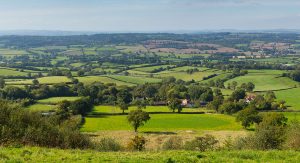
Some of the wonderful scenery around the town today. Image: Charlesy/Shutterstock.com
Fire!
Sadly the town suffered a couple of catastrophic fires in short order during the 18th Century, with the first striking in 1747 and then again in 1765. Most of the town was affected, however, it does mean that the high street is almost exclusively comprised of Georgian architecture, which adds to its character.
Fortunately, these fires did nothing to stop the towns rise both as a local market town and of course s the pre-eminent English lacemakers, and when Queen Victoria was married in 1840 her wedding dress was made from Honiton lace. She was so impressed by the quality that she commissioned the families christening dresses to be made of their lace.
This naturally increased the demand exponentially and sadly led to the demise of the intricately handcrafted designs as mechanics were introduced to speed production. However, it remained a popular fashion statement through much of the 19th Century.
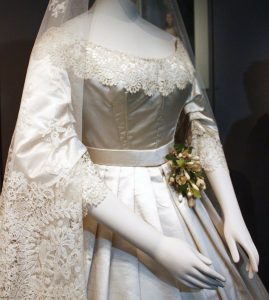
This 1865 Wedding Dress is trimmed with Honiton lace.
Image Credit: Wikipedia Loves Art participant “va_va_val” / CC BY-SA
Here Comes A Train
The railway arrived in 1860 increasing the town’s links to neighbouring regions, and thankfully the local station survived the Beeching purges. Today is an important link in the local economy.
Honiton Pottery
Honiton developed a pottery industry in the late 18oo’s and it became quite famous when Charles Collard set up his pottery business in the High Street in 1918. He was already a well-known figure in West Country pottery circles having previously owned Crown Dorset Art Pottery in Poole.
This reached a peak in the 1930s but declined after WWII and sadly the last remnants of production left the town in 1997 when nearby Dartmouth Pottery bought the trading name and production ceased. The pottery its self is quite collectable (and reasonably priced) and there is even a Honiton Pottery Collectors Society.
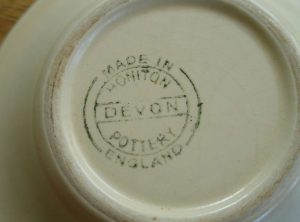
Honiton Pottery is quite collectable nowadays.
Honiton Today
Today the town is largely an agricultural town with a population of around 12,000. Being ideally located in the fertile Otter Valley and it even has its own well attended and long-running Agricultural Show and is also known as the regions antique’s capital, having a plethora of both Antique and arts & crafts shops. You could literally spend a day just browsing these.
So now we have covered a bit of the town’s history, how about a few interesting facts:
Not A Lot Of People Know That…
The first popular Honiton Agricultural Show took place in 1890.
Honiton’s twin owns are Mézidon-Canon in France and Gronau-Leine in Germany.
The town is called Honetone in the Doomsday Book
The christening robe of King Edward VII was made of Honiton lace.
On 23rd October 1967, Honiton was the site of Englands first ever Royal Mail Post Bus which connected the town with several local villages. combined mail collection with collecting the post. Sadly it no longer runs.
Famous Locals
Honiton has had a few notable people born in its boundary including the following:
- Royal Navy Captain George Blagdon Westcott who commanded HMS Majestic during the Battle of the Nile in 1798. He died in battle and a few years later Lord Admiral Nelson visited Honiton and gave his Nile Medal to his surviving family as a mark of respect for his valour.
- 18th Century Artist Ozias Humphry who was an elected member of the Royal Academy of Arts from 1791. Best known for his Miniature paintings and for being appointed Portrait Painter in Crayons to the King. Sadly his career was cut short by blindness (His sight finally failed in 1797).
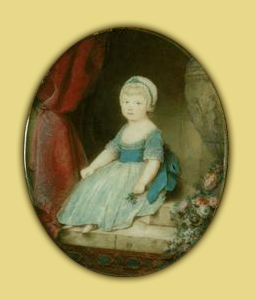
Miniature painting of Princess Charlotte – 1769 Ozias Humphry / Public domain
- Jo Pavey: Athlete Jo Pavey and Gold Medal winner at the 2014 European Championships in the 10,000m
- William Salter: Artist who painted The Waterloo Banquet in 1836 to commemorate the anniversary of the famous battle.
- Maurice Edgar Setters: Professional footballer and FA Cup winner with Manchester United in 1963
Things To Do & See
The countryside around Honiton is part of the East Devon Area of Outstanding Natural Beauty, and boasts many local beauty spots including magnificent Iron Age Hembury Fort and Blackbury Camp, both carpeted with bluebells in late spring. Honiton is perfect for countryside pursuits, walking and getting back to a slower pace of life.
Just a few miles from the Jurassic Coast, take a day trip to Seaton, Sidmouth and Beer and admire the stunning coastal landscape, enjoy a day at the beach and of course some local fresh fish and chips or ice cream.
Places to visit
The buildings of High Street are almost all Georgian, dating from after the two fires of 1747 and 1765. Of particular interest are Marwood House, 1619, and the Manor House, which was originally a coaching inn (the added porch is 19th-century). Honiton Garage dates from about 1700 and the Market Hall (which originally had arcades on the ground floor and an assembly room above) has a modest early-19th-century stone front.
Churches
St Michael’s Parish Church, which was rebuilt in 1911 after a fire, is situated on a small hill above the town. The old church was large and perfectly rectangular: it was built in the Perpendicular style, with two aisles, two transepts (which did not project), and the chancel and two chancel chapels equal to it in length.
The west tower and the outer walls are all that remains of the old building. The cost of the original building was paid by Bishop Courtenay of Exeter, lord of the manor of Honiton (west part) and by John and Joan Takell (east part).
St Pauls Church
The mid-19th-century St Paul’s Church was designed by Charles Fowler and is situated in the centre of the town. Its erection in 1835 required an act of Parliament and the demolition of half of the adjacent Allhallows Chapel. It was built in 1837–38 in a style incorporating elements of Romanesque architecture. There are pinnacles on the tower and the arcades inside have tall columns; above the nave is a clerestory which resembles those in early Christian basilicas.
Museums
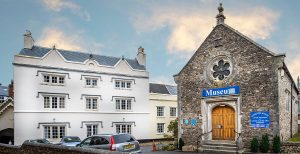
The Allhallows Museum of Honiton Lace is a must-visit if in town.
Image: Nigel Jarvis/Shutterstock.com
Allhallows Museum of Lace and Local Antiquities claims to hold one of the most comprehensive collections of Honiton lace in the world. It is located in a building, claimed to be the oldest still extant in Honiton, which formerly belonged to Allhallows School from the 16th Century until the 1930s.
Also, a visit to Honiton isn’t complete without a trip to the award-winning Thelma Hulbert Gallery, located in the impressive Elmfield House on Dowell Street. It features an ever-changing range of exhibitions from both local and national artists and a permanent display of Thelma Hulbert’s work. Admission is free and if you love art then this is the place to head.
Things to do In And Around Honiton
Pop along to the Hot Pennies Ceremony. This takes place annually on the first Tuesday after 19 July in the towns High Street and dates back to the 11th Century. The ceremony has its roots in the somewhat questionable practice of the one time landed gentry who took pleasure in throwing hot pennies from windows to local peasants, who got burns to their hands in exchange for their penny. Theis less than altruistic gesture helped bring people to the town from the surrounding area to the subsequent fair. Today not so hot pennies are still thrown from a number of balconies in the High Street.
Agricultural Show
Honiton is host to the annual Honiton Agricultural Show, an event traditionally held on the first Thursday of August in fields near the town, dating back to 1890.
Go Shopping
As we said there are plenty of antique shops to keep you busy
Go Bird Watching
One of the few places that you might see the rare Cirl Bunting.

You might spot one if you are lucky.
Image: John Navajo/Shutterstock.com
Football
Go and watch Honiton FC who play Honiton FC who won the Devon & Exeter League Premier Division in 2016–17 and currently play in the South West Peninsula League.
Getting To Honiton
Now you are desperate to see this gem of a town which hides its self so well in the rolling countryside of East Devon, we might as well tell you how to get there:
Travelling by road
In Devon it would be fair to say all roads lead to Honiton as it has no less than five A-roads intersecting it; the A303, A30, A35, A373 & A375! Thus it has direct road links to London via A303 & Bristol via the A30. Closer to home it also has pretty much direct routes to Bournemouth, Exeter, & Yeovil. If you are on a driving holiday in the south of England then you really have no excuse for not paying a visit.
Air Links
Honiton is around 13 miles from Exeter airport.
Train Services
Honiton railway station is on the West of England Main Line and is served by South Western Railway services to London Waterloo and Exeter St Davids. Opened 1860
Located on the main London Waterloo to Exeter line (West of England Line) trains stop regularly at Honiton. There is a staffed ticket office and toilet facilities at the station along with ticket machines on the platform outside of office opening hours.
For information on train times please visit South Western Railway here
Public Transport
Taunton – Honiton – Stagecoach Bus 20 (Via Wellington & Hemyock)
Seaton – Honiton – Stagecoach Bus 20 (Via Colyford)
Axminster – Honiton – Stagecoach Bus 4
Exeter – Honiton – Stage Coach Bus 4, 4A & 4B
For information on timetables please visit the Stagecoach website here
Where to Stay in Honiton
The town its self is fairly well provided for accommodation wise with several small hotels and numerous Bed & Breakfasts available. There is also a Premier Inn and numerous other larger establishments within a 10-mile radius of the town.
Thinking of Moving Here
Whatever don’t forget to register and join us Five Minutes Spare.
